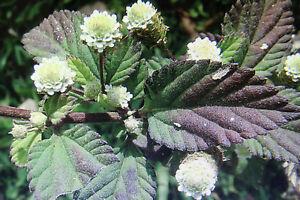Once established, Aztec Sweet Herb is a hardy plant
The Native Americans we know as Aztecs were among the first civilizations to have mandatory schools for all children. They also had a complex accounting system, and built their capital city on a swamp because it fulfilled a prophecy.
The wandering tribe’s prophecy said to build a city where they saw an eagle on top of a cactus with a snake in its beak. This is why modern Mexico City stands in swampy islands in the middle of Lake Texcoco. The eagle, cactus, and snake are in the center of Mexico’s flag.
The Aztecs grew an herb that was incredibly sweet, the Aztec Sweet Herb (Lippia dulcis). This easy-to-grow sweet herb is perennial in warmer climates or can be grown in a pot or even dangling from a hanging basket. The leaves change to red when temps drop below 50 degrees F, making an eye-catching display.
Aztec Sweet Herb grows best where it gets full sunlight and warmth, especially during cold months. The ideal soil pH is between 6.0 and 8.0, which means it grows well in a wide range of soils from acidic to alkaline. Plant Aztec Sweet Herb in soil that drains easily. Let the soil get almost completely dry between waterings.
These are fast-growing herbs that creep along the ground. Once established, Aztec Sweet Herb is a hardy plant that gets by even when neglected. Plants and seeds are available from online sellers such as Underwood Gardens (www.underwoodgardens.com or phone 888-878-5247) or J. L. Hudson, Seedsman, Box 337, La Honda, CA 94020-0337, or Companion Plants (www.companionplants.com).
The first time you eat a leaf you will be shocked at how sweet it is. These natural sweeteners are perfect added to a fruit salad or smoothies. The roots have a licorice flavor. The leaves get their sweet flavor from a compound called “hernandulcin” that is more than 1,000 times sweeter than table sugar.
Often, over half of Aztec Sweet Herb's essential oil is camphor, so it is best not to ingest very many of the leaves. Be aware that camphor chemicals can be potentially toxic if eaten in large amounts. When used in moderation, they seem fine. This herb is very popular in Japan. In traditional medicine, Aztec Sweet Herb is used as an expectorant for coughs, and to treat asthma, bronchitis, colds, and even colic in babies.
Your Aztec Sweet Herb will bloom with very tiny white flowers clustered in half-inch-wide, daisy-like flowers. The herb plant will grow one to two feet tall. Because it tolerates heat, this is far easier to grow than the other sweet herb, Stevia. Aztec Sweet Herb produces sweet leaves year-round, unlike Stevia which dies after a single season.
Everything about this plant seems to make it durable. Even its seeds can live for years before planting, if you keep them in a cool, dry area out of direct sunlight.
This hardy plant responds well to ample water and occasional feedings of compost. To start your Aztec Sweet Herb seeds, use a good commercial potting soil with extra sand for drainage. Carefully sprinkle seeds on top of the potting soil, pressing them into the soil gently. Water with a mist sprayer so you do not wash the seeds away.
For an interesting plant with occasional use as intense sweetener, the Aztec Sweet Herb is hard to beat. And you don't even have to wait to witness an eagle perched on a cactus with a snake in its beak.
















































